Elephant Management and Poaching in South Africa
- Lisbeth
- Site Admin
- Posts: 67388
- Joined: Sat May 19, 2012 12:31 pm
- Country: Switzerland
- Location: Lugano
- Contact:
Re: Project Ivory launched at the Kruger National Park
A lot of talks. Hopefully, it will not end like with the rhinos 
"Education is the most powerful weapon which you can use to change the world." Nelson Mandela
The desire for equality must never exceed the demands of knowledge
The desire for equality must never exceed the demands of knowledge
- Richprins
- Committee Member
- Posts: 75964
- Joined: Sat May 19, 2012 3:52 pm
- Location: NELSPRUIT
- Contact:
Re: Elephant Poaching in South Africa
I spoke to someone yesterday about the danger to big tuskers in Kruger. She said rhino poachers were indeed turning to ellies as the rhino are running out and it is tricky to get rhino unless one has an inside contact. However, big tusks are extremely heavy. In one case in the north a reasonably big bull was poached or at least the tusks acquired in the veld, but they were too difficult to carry so the poachers eventually left them near the closest road with the intent of fetching them later with a vehicle.
So not a big threat. However the situation could change as more employees in Kruger get involved in poaching themselves.
So not a big threat. However the situation could change as more employees in Kruger get involved in poaching themselves.
Please check Needs Attention pre-booking: https://africawild-forum.com/viewtopic.php?f=322&t=596
- Lisbeth
- Site Admin
- Posts: 67388
- Joined: Sat May 19, 2012 12:31 pm
- Country: Switzerland
- Location: Lugano
- Contact:
Re: Elephant Management and Poaching in South Africa
It has been done elsewhere, so it can most likely also be done in Kruger. It is most likely a question of organisation and money from the criminal cartels. They have to change from rhino to elephants 
"Education is the most powerful weapon which you can use to change the world." Nelson Mandela
The desire for equality must never exceed the demands of knowledge
The desire for equality must never exceed the demands of knowledge
- Lisbeth
- Site Admin
- Posts: 67388
- Joined: Sat May 19, 2012 12:31 pm
- Country: Switzerland
- Location: Lugano
- Contact:
Re: Elephant Management and Poaching in South Africa
Elephant bull with failing eyesight treated for serious injuries
Posted on 10 May, 2019 by News Desk in News, Wildlife and the News Desk post series.
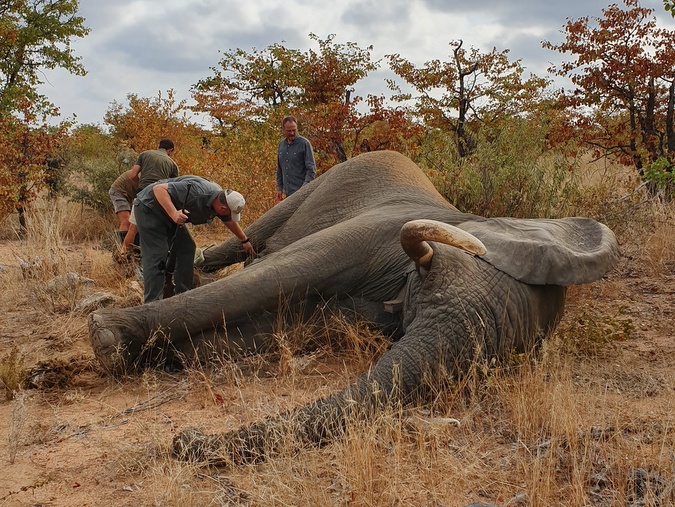
Image source: Umbabat Private Nature Reserve
WARNING: CONTAINS GRAPHIC CONTENT
Earlier this week Elephants Alive discovered one of their collared elephant bulls seriously injured in Umbabat Private Nature Reserve (UPNR). Not knowing the cause of the injury, they immediately got in touch with the warden of the reserve, Bryan Havemann, who, after an assessment of the bull, secured a permitfrom Mpumalanga Tourism and Parks Agency (MTPA) for the team and vets to intervene.
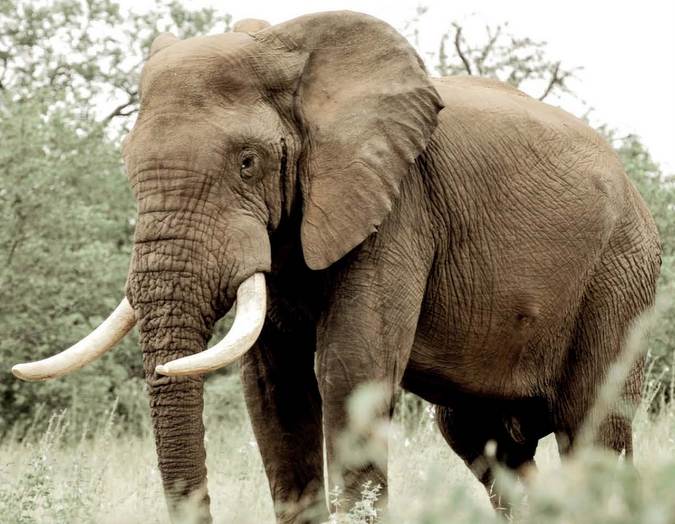
Matambu is a collared bull in his prime, but with failing eyesight © Elephants Alive
The elephant in question is known as Matambu, a bull in his prime but with failing eyesight. He is considered to be placid in nature and quite docile, which made darting him on foot relatively stress-free and quick by a team which included Wildvets, Dr. Joel Alves and Havemann.
“The reserve doesn’t normally intervene when injuries are as a result of natural causes,” said Havemann, “but in Mutambu’s case we couldn’t be sure what the cause of the injury was until the wounds were assessed”.
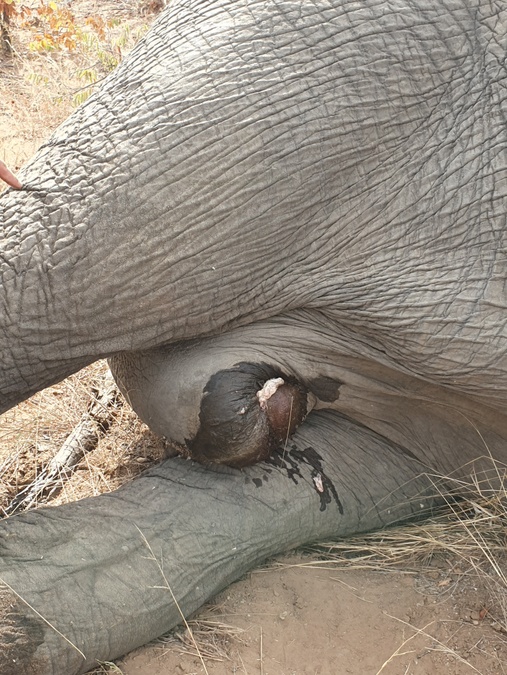
Image source: Umbabat Private Nature Reserve
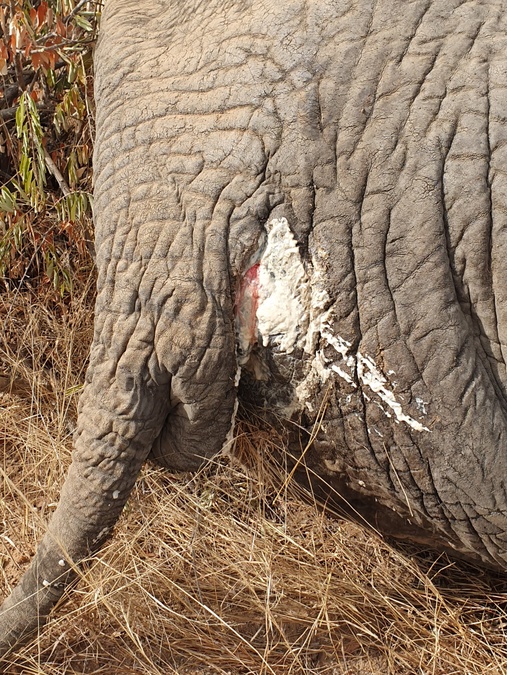
Image source: Umbabat Private Nature Reserve
It was established during Matambu’s assessment that the injuries to his genital and rump area were most likely caused by the tusk of another elephant bull.
First collared in 2006 by Elephants Alive, Matambu has proved to be vital to their studies. He has partial sight in one eye (which has a cataract), and blind in the other. This was discovered in 2017 during a routine change of batteries in his collar when a veterinary ophthalmologist was called in to assess him. Neither eye is likely causing him any pain or distress, however, the cataract will likely cause complete blindness over time.
Once Elephants Alive discovered that Matambu was seriously injured, they felt it was important to intervene to treat him as he is an important study animal. Aside from this serious injury, he is in relatively good health.
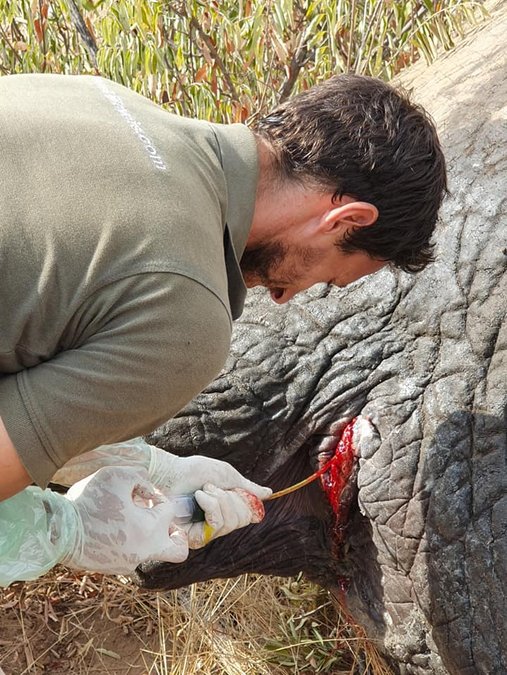
Image source: Umbabat Private Nature Reserve
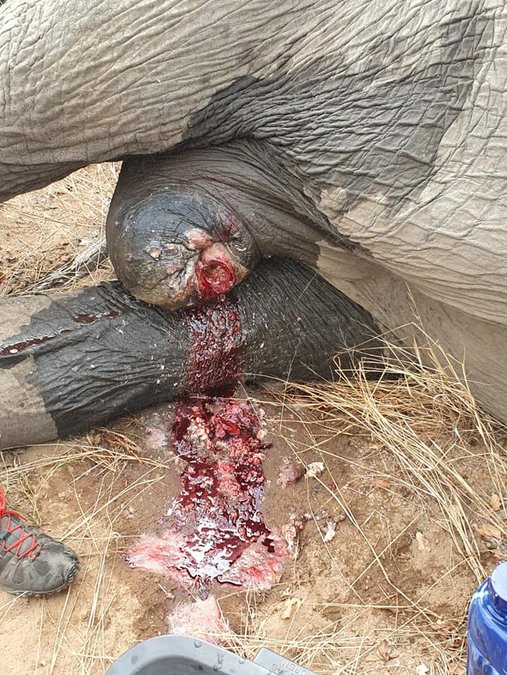
Image source: Umbabat Private Nature Reserve
After an hour of being tranquillised and successfully treated, Matambu woke up and slowly walked away to live another day. Elephants Alive and the reserve will continue to monitor his recovery.

Image source: Umbabat Private Nature Reserve
Posted on 10 May, 2019 by News Desk in News, Wildlife and the News Desk post series.

Image source: Umbabat Private Nature Reserve
WARNING: CONTAINS GRAPHIC CONTENT
Earlier this week Elephants Alive discovered one of their collared elephant bulls seriously injured in Umbabat Private Nature Reserve (UPNR). Not knowing the cause of the injury, they immediately got in touch with the warden of the reserve, Bryan Havemann, who, after an assessment of the bull, secured a permitfrom Mpumalanga Tourism and Parks Agency (MTPA) for the team and vets to intervene.

Matambu is a collared bull in his prime, but with failing eyesight © Elephants Alive
The elephant in question is known as Matambu, a bull in his prime but with failing eyesight. He is considered to be placid in nature and quite docile, which made darting him on foot relatively stress-free and quick by a team which included Wildvets, Dr. Joel Alves and Havemann.
“The reserve doesn’t normally intervene when injuries are as a result of natural causes,” said Havemann, “but in Mutambu’s case we couldn’t be sure what the cause of the injury was until the wounds were assessed”.

Image source: Umbabat Private Nature Reserve

Image source: Umbabat Private Nature Reserve
It was established during Matambu’s assessment that the injuries to his genital and rump area were most likely caused by the tusk of another elephant bull.
First collared in 2006 by Elephants Alive, Matambu has proved to be vital to their studies. He has partial sight in one eye (which has a cataract), and blind in the other. This was discovered in 2017 during a routine change of batteries in his collar when a veterinary ophthalmologist was called in to assess him. Neither eye is likely causing him any pain or distress, however, the cataract will likely cause complete blindness over time.
Once Elephants Alive discovered that Matambu was seriously injured, they felt it was important to intervene to treat him as he is an important study animal. Aside from this serious injury, he is in relatively good health.

Image source: Umbabat Private Nature Reserve

Image source: Umbabat Private Nature Reserve
After an hour of being tranquillised and successfully treated, Matambu woke up and slowly walked away to live another day. Elephants Alive and the reserve will continue to monitor his recovery.

Image source: Umbabat Private Nature Reserve
"Education is the most powerful weapon which you can use to change the world." Nelson Mandela
The desire for equality must never exceed the demands of knowledge
The desire for equality must never exceed the demands of knowledge
- RogerFraser
- Site Admin
- Posts: 6003
- Joined: Wed Sep 18, 2013 9:36 pm
- Country: South Africa
- Location: Durban
- Contact:
- Richprins
- Committee Member
- Posts: 75964
- Joined: Sat May 19, 2012 3:52 pm
- Location: NELSPRUIT
- Contact:
Re: Elephant Management and Poaching in South Africa
Please check Needs Attention pre-booking: https://africawild-forum.com/viewtopic.php?f=322&t=596
-
Klipspringer
- Global Moderator
- Posts: 5862
- Joined: Sat Sep 14, 2013 12:34 pm
- Country: Germany
- Contact:
Re: Elephant Management and Poaching in South Africa
Very interesting to read South Africas proposal to transfer elephants from Appendix I to Appendix II (CITES CoP9 1994)
Culling of elephants was not (only) seen as a management tool to keep elephant numbers low but to sell ivory and other elephant products.
https://cites.org/sites/default/files/e ... odonta.PDF
BTW: same proposal in 1994 for white rhino: https://www.cites.org/sites/default/fil ... herium.PDF
Culling of elephants was not (only) seen as a management tool to keep elephant numbers low but to sell ivory and other elephant products.
Some other intersting data in the document (population data and historic ranges etc)The mean annual production of ivory from Kruger amounted to 874 tusks weighing 5 067,9 kg per year for the period 1973 - 1993 (Table 1 7). Ivory sales from the park yielded USD 730 900 per year to the park budget from 1985 - 1989 (Table 11). No ivory has been sold internationally since the Appendix I listing and the current stock of ivory held by the park amounts to 2 282 tusks with a mass of 14 2 58,5 kg (Table 1 8). Sales of elephant leather, most of which entered into international trade yielded USD 394 348 per year from 1985-1989.
https://cites.org/sites/default/files/e ... odonta.PDF
BTW: same proposal in 1994 for white rhino: https://www.cites.org/sites/default/fil ... herium.PDF
- Richprins
- Committee Member
- Posts: 75964
- Joined: Sat May 19, 2012 3:52 pm
- Location: NELSPRUIT
- Contact:
Re: Elephant Management and Poaching in South Africa
iSimangaliso elephants collared
A further number of elephants at Western Shores will also be fitted with collars
18 hours ago
Tamlyn Jolly

One of the six elephants recently fitted with tracking collars at uMkhuze Game Reserve PHOTO: iSimangaliso
TO support its ongoing scientific research, the iSimangaliso Wetland Park authority recently collared six of its 100 elephants in the uMkhuze Game Reserve.
Five females and one bull received their new necklaces earlier this month.
The telemetry collars allow regular monitoring of these animals within the wetland park, which in turn aids in the conservation of the species.
‘The elephants receiving collars are known individuals, chosen because of either their status as matriarch of a herd, or in this case, a specific lone bull who favours the Mantuma Camp area,’ said uMkhuze Conservation Manager, Eduard Goosen.
A further 100 elephants live in the Western Shores area of Lake St Lucia, occasionally traversing the lake to visit the Eastern Shores section.
Some of these individuals will also be collared in the near future.
Costs associated with the purchasing and fitting of the collars, including the required veterinary services, are funded by the iSimangaliso’s Rare and Endangered Species fund, with money raised through a variety of events organised or permitted by the iSimangaliso authority.
‘We are very grateful to all of our past participants in events and fund-raising initiatives that have helped to grow this fund so we are able to support the work undertaken by our conservation partner, Ezemvelo KZN Wildlife, in iSimangaliso,’ said iSimangaliso Executive Manager of Biodiversity and Conservation, Sizo Sibiya.
https://zululandobserver.co.za/195478/i ... -collared/
A further number of elephants at Western Shores will also be fitted with collars
18 hours ago
Tamlyn Jolly

One of the six elephants recently fitted with tracking collars at uMkhuze Game Reserve PHOTO: iSimangaliso
TO support its ongoing scientific research, the iSimangaliso Wetland Park authority recently collared six of its 100 elephants in the uMkhuze Game Reserve.
Five females and one bull received their new necklaces earlier this month.
The telemetry collars allow regular monitoring of these animals within the wetland park, which in turn aids in the conservation of the species.
‘The elephants receiving collars are known individuals, chosen because of either their status as matriarch of a herd, or in this case, a specific lone bull who favours the Mantuma Camp area,’ said uMkhuze Conservation Manager, Eduard Goosen.
A further 100 elephants live in the Western Shores area of Lake St Lucia, occasionally traversing the lake to visit the Eastern Shores section.
Some of these individuals will also be collared in the near future.
Costs associated with the purchasing and fitting of the collars, including the required veterinary services, are funded by the iSimangaliso’s Rare and Endangered Species fund, with money raised through a variety of events organised or permitted by the iSimangaliso authority.
‘We are very grateful to all of our past participants in events and fund-raising initiatives that have helped to grow this fund so we are able to support the work undertaken by our conservation partner, Ezemvelo KZN Wildlife, in iSimangaliso,’ said iSimangaliso Executive Manager of Biodiversity and Conservation, Sizo Sibiya.
https://zululandobserver.co.za/195478/i ... -collared/
Please check Needs Attention pre-booking: https://africawild-forum.com/viewtopic.php?f=322&t=596


